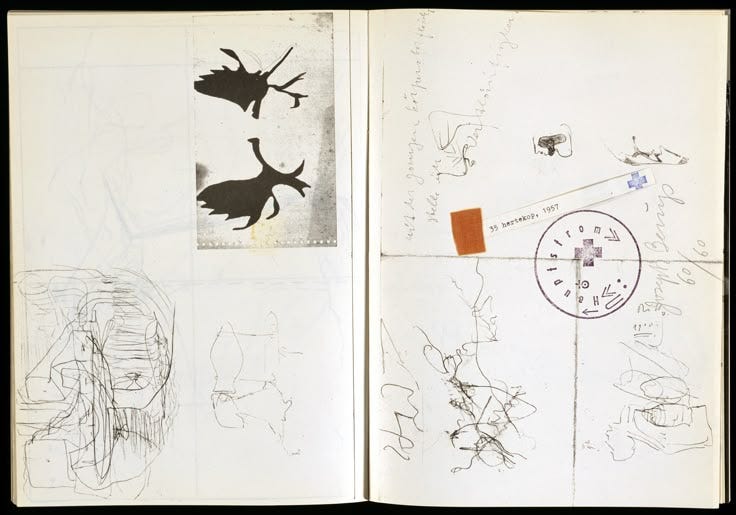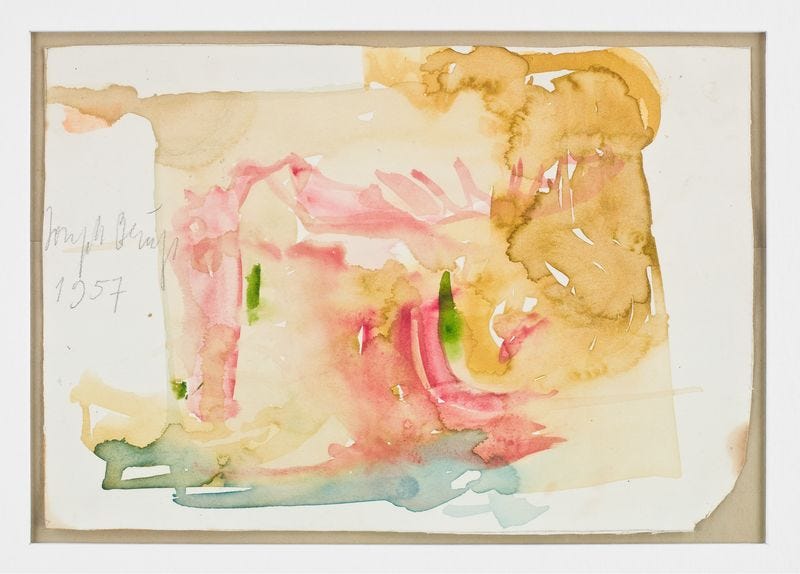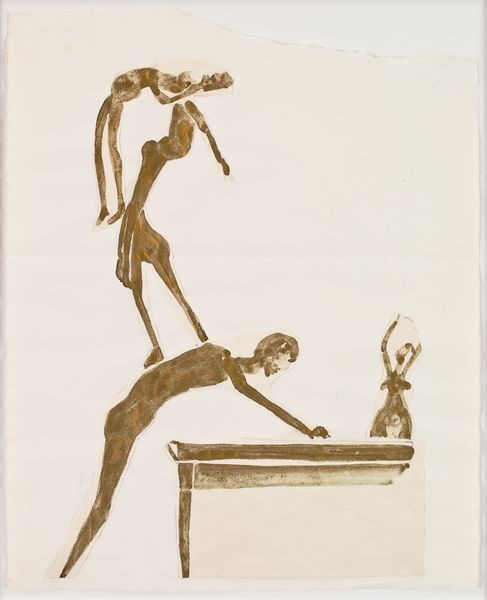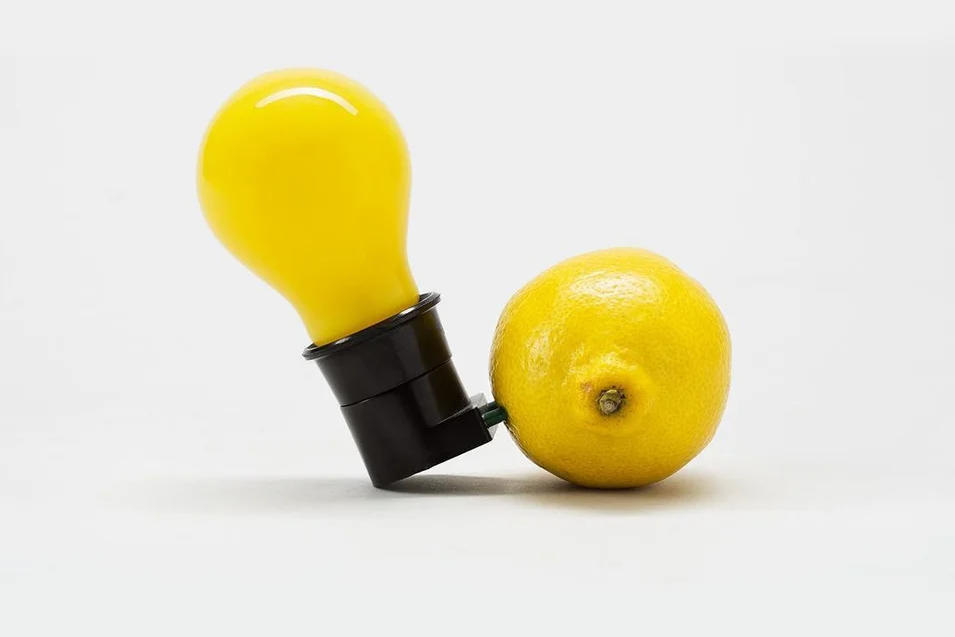The only objects I’ve ever collected are books about the German artist, Joseph Beuys. Monographs, interviews, biographies, criticism. Usually, I look at art books for the pictures but I’ve read all my Beuys books, cover to cover, and somehow I still remain mystified by both the art and artist. This is what keeps me engaged in a lifelong study of his work.
On February 8th, I was supposed to visit the newest Beuys exhibition at The Broad museum in Los Angeles, but that morning, my home and art studio burnt to the ground. Instead of seeing the show, I was staring at the news, feeling the shock of every layer of loss: my community, memories, art, archives, and of course, my collection of Beuys books.
Beyond culture, the Eaton Fire took great swathes of wilderness. Wildlife died. Street trees were cooked alive. On my property alone, we lost two toyons, a sweetgum, three palms, and six fruit trees. The blood orange is now a burnt limb reaching from out of the earth.
After seeing the ruins of our home, I have assumed all the plant life in the area had been destroyed, but this is not what happened. Hundreds of oaks are still in Altadena, alive and well, growing amongst a landscape of grey rubble.
*
“I think the tree is an element of regeneration which in itself is a concept of time. The oak is especially so because it is a slowly growing tree with a kind of really solid heart wood. It has always been a form of sculpture, a symbol for this planet ever since the Druids, who are called after the oak. Druid means oak. They used their oaks to define their holy places.” — Joseph Beuys
In 1982, Joseph Beuys planted 7,000 oaks across the city of Kassel. The project took five years and was only completed after his death. The Broad show is centered around the mission of this work. The exhibition takes its name, In Defense of Nature from an ecological activism campaign that Beuys, his university students, and his dealer, Lucrezia de Domizio, began in the 1980s, involving pamphleteering and digging.
I learned about this from a now-burnt book of the same name written by de Domizio. The book chronicles a trip Beuys took to the Seychelles in his 60s, near the end of his life. There, he studied the landscape and planted two trees. By the end, he was creating art by creating life.
I came to know Beuys through books, not exhibitions, which, for me, suits the slow unfolding nature of his work. Long before I saw his sculpture in person, it filled my imagination from images on pulped trees. Generally speaking, I don’t need to read more than a book or two about any artist — too much knowledge muddies the work — but reading about Beuys has only deepened the mystery.
I think everyone, including the artist, has worked to keep it that way. Perhaps this is because Beuys’ body of work is a complex and messy, and involves a constellation of elements: pedagogy, fluxus performance, sculpture, music, philosophy, politics, Celtic mythology, and ecology. He revolted against the university where he taught, founded an alternative political party and a free university. His identity is equal parts teacher, shaman, activist, and scientist, and he nearly always dressed in his fisherman outfit, suggesting that his real work was out in the wilderness somewhere. The Broad attempts to organizes all these elements of his work into separate rooms, and still, it is nearly impossible to make a sensible whole from the parts. Beuys refuses to be reduced.
Some people might consider this unknowability a failure, or an annoying affect in the work — obfuscation for its own sake. There’s truth to that. Beuys lied about his biography, famously telling myths about his rebirth at the hands of indigenous people in Eastern Europe. He usually spoke with a frustrating, poetic syntax. His drawings invokes opaque, metaphysical concepts, and the sculptures look like archaic relics, built of stone and fat. He covered his head in honey and gold leaf, and explained his art to a dead hare.
This is an artist who is clearly and actively creating mystery. For me, this intention does not diminish the work’s hypnotic effect, because the art is the mystery, and he builds it well. True mystery is endlessly generative. Superficial mystery, like that of bad TV show, fizzles after a season. Beuys has been generating curiosity for long after his death, which is why his work continues to inspire artists, exhibitions, and new books.
If there is any concept at the heart of Beuys’ work, it is the immateriality of art. For Beuys, art is in all of us, around all of us, and we are all artists. It is the vital force of the universe. Through his suggestion, his objects becomes portals into the primordial reality of energy as it flows from the earth to animals to humans. The material becomes alive.
*
I am not usually a sentimental person, and yet, total material loss has felt distinctly like the loss of life. The emotions may be different in magnitude but strangely similar in quality. As with the death of a person, the pain is not really from the physical loss but from the loss of an immaterial presence. We miss what the physical thing did for us. When I passed my Beuys shelf, a single glance at a spine could give off just enough mystery to realign my thinking.
Throughout the grieving process, people have repeatedly reminded me that what I lost are “just things.” I know this is their way of cheering me up: pointing out the deadness of inanimate objects and the aliveness of my family. I have tried to believe this, but ultimately, I’m not sure I make this kind of distinction.
I lost of the guitar my mother gave before she died. This is the instrument I became a musician while playing and the primary guitar I’ve played in hundreds of concerts around the world. I do not miss the wood and strings, but the feeling that the guitar contained. This was a tool for inspiring something within me, and its presence was better at doing so than my memories alone.
This is what art does. Perhaps it would be best if none of us needed objects and we could use only our mind to conjure up our feelings. Like Buddha, we would be sovereign. But I love art precisely because of it’s capacity to transmit such experiences that I can not invoke on my own. I have dedicated my life not to beautiful objects but to the unseen forces they transmit. For me, art is not a thing; it is a feeling, just as mother is a feeling, just as home is a feeling.
*
Beuys immaterial interest does not diminish his fetish for objects. He’s a contradiction. He loves stuff. His vitrines are tableaux of curiosities — a chunk of raw stone, a strip of felt, a little dusty bottle of oil. These are the remnants of a man sensitive to the vital energy humming in things. He collects what nobody else notices. This is the same objectification that continues to pump out new Beuys books, 60 years after his death, and what inspired Eli Broad to collect Beuys’ series of “multiples,” which are the primary subject of the new show.
The multiple is Beuys’ word for an edition. It’s his way of filling the world with more things. A multiple could be a poster, print, sculpture, drawing, or fetish, sometimes finished with his stamp or signature. These objects are made in large batches, and are inexpensive in comparison to his sculptures. They suit Beuys’ populist philosophy: everyone gets an an object.
One iconic multiple is the Capri Battery: a yellow lightbulb plugged into a real lemon, which needs to be regularly replaced to avoid rotting. It’s an elegant distillation of the energy transference at the heart of Beuys’ work: from the organic to the technological, the material to the immaterial. Beuys once said, “If you have all my multiples then you have me completely,” as if he had magically imparted his life energies to his objects. If this is true, what would happen if they all burnt?
*
When I evacuated on January 7th, the only book I brought with me was “What is Money?” a roundtable conversation with Beuys on the book’s titular question. I packed the book just as a way to get myself in the headspace for the show the next day, when I still thought I might go. I also wanted to have some small part of Beuys with me.
I had not read the book before and have not had the time to read it since. It now seems to have been an appropriate choice, preparing me for the future of financial upheaval. Money has been a charged topic in this post-disaster moment, and I am looking forward to getting the Beuysian take on it. From what I understand, he wants to replace money with art.
I often turn to Beuys when I’m need an abstract perspective on a topic — persona, teaching, death. Since the fire, I’ve thought about his trajectory as an artist. His career, as we mostly know it, began in his early 40s. Work before this is scant and rarely discussed. Knowledge of his emerging years is more novelistic than biographical, built from Beuys’ fanciful tales rather than factual documents. Some of this is by design, to transform his youthful involvement with the Nazis into something mythological. But also, he was just a late bloomer.
Now, with nearly all my early work and archives erased, the first half of my life is an abyss. Paintings, journals, notebooks, and childhood work — gone. When I look to the future, it has helped me to remember that with his late and brief period of making work, Beuys created an entire world.
*
Beuys began creating his multiples in 1965, when he was 44, which I learned when I finally visited the Beuys show, six weeks after the fire. The show begins with a timeline of his life, the first two thirds of which, is barely discussed.
The work in the show was quiet and subtle — photographs of his performances and prints of his drawings, scribbled in shit-brown and rabbit’s blood. Unfortunately for me, my viewing experience was accompanied by the roaring din of pop music reverberating through the museum. A wash of Katy Perry’s “fireworks” was punctuated by applause and a blurred shrieking. As I looked at each work, I could not help but wonder what could possibly be producing such a terrible sounds.
When I reached the end of the exhibition, I saw that an aerobics class was being held beside a silent video of Beuys planting his first oak trees, and that the class’ instructor was using a piercing squeal to direct her students. The Broad often colors their exhibitions with “fun” programming, and for some unknown reason, they decided some cardio would pep up this gentle, introspective show.
Sometimes I prefer books to exhibitions. I’ve entered much of my favorite art through the page and not through the gallery, where, for example, one woman might take a selfie in front of Beuys’ work about free education, while another woman photographs her professionally. Like a good novel, a book allows for a unfettered, immaterial fantasy in the mind; and like multiples, books are affordable. Among the first items I replaced were a few items from my Beuys library, the newest of which was the catalog for the Broad show.
Nearly half of the In Defense of Nature monograph is dedicated to The Broad’s continuation of 7,000 Oaks. The museum has planted 100 new oak trees in Los Angeles’ Elysian Park. It’s a presciently timed and well-needed work. Trees are air purifiers. They filter toxic smoke from urban fires and pump out oxygen to lift our mood — all of which Beuys clearly understood. He saw himself as a healer.
Altadena, where I lived, was one of the great tree-lined neighborhoods of L.A., and therefore, had some of the cleanest air in the city. This was due to the aquifer beneath the town and the orographic effect of the San Gabriel mountains to the east. This created enough moisture to grow the mile-long line of towering pines on Christmas Tree Lane, and the grove of coastal oaks in Cobb Estate, where the Marx Brothers once lived.
Live oaks are native trees, familiar with California fire — maybe even invigorated by it — and they can thrive amongst our tragedy. Human intelligence has made flammable homes that fill the air with toxic fumes, but plant intelligence has made oaks robust with vitality and heartwood.
Without calculation or language, these beings have forged an ongoing relationship with fire. How have they done this? How has the Pechanga great oak, not far from Altadena, lived to be 2,000 years old? How have oaks been surviving on this planet for 56 million years, through the ice age and every other upheaval of the climate? These are true, indelible mysteries and they are worthy of holding our attention forever.
A different version of this essay appeared in Cultured magazine.








